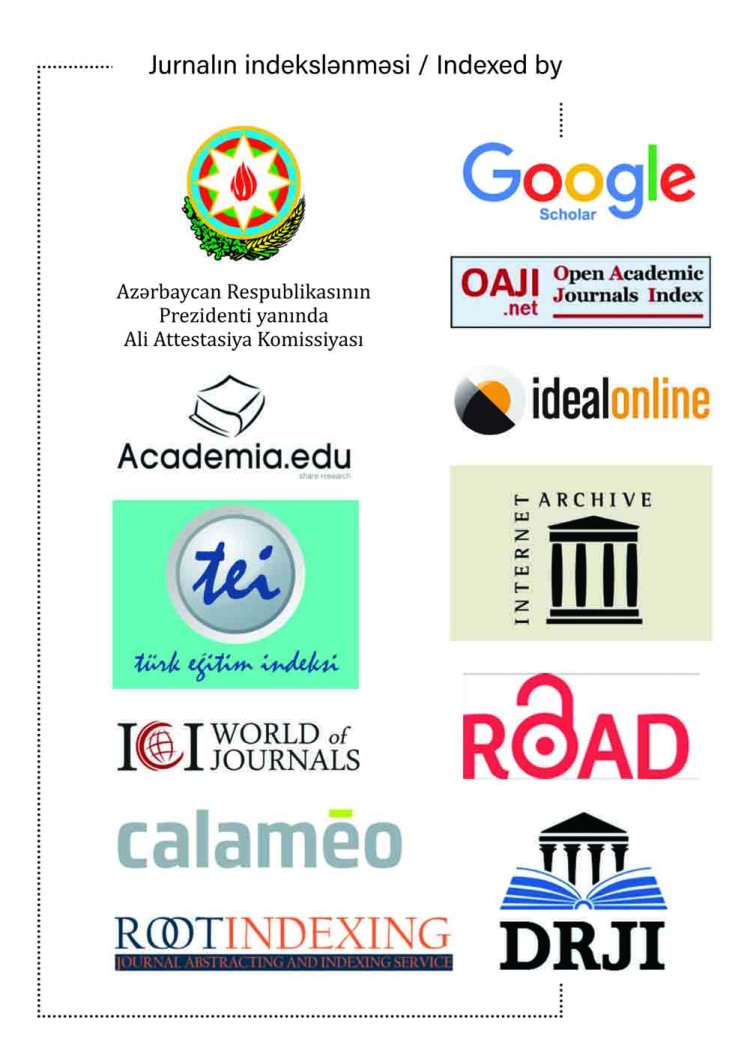COMBINING WEB-BASED INFORMATION LITERACY WITH CRITICAL THINKING CONCEPTS: RECOMMENDATIONS FOR PEDAGOGICAL PROGRAMS OF AZERBAIJAN
GUNEL KARIMOVA
The present study attempts to explore how prepared students of teacher education are and how confidently they perceive certain critical thinking concepts related to information literacy at various universities of Azerbaijan. The study particularly focuses on two widely spread phenomena on the modern web i.e., evaluation of authority and logical fallacies such as emotional appeal and overgeneralization. The research utilized an online questionnaire conducted with undergraduate students studying in various pedagogical programs at different universities of Azerbaijan. It appears that most of the study respondents seemed to be neither familiar nor confident with the essence of critical thinking concepts in terms of web-based information literacy. The results highlight a broader issue of digital naivety where teacher education students might not fully understand the potential pitfalls of relying on unreliable sources and being unaware of how to contextualize web-based information. In response to the results of the present study, the paper argues that taking a multidisciplinary approach by combining the two constructs i.e., critical thinking and web-based information literacy, in a course might allow for a more responsive ground in teacher education programs of Azerbaijan.
INTRODUCTION
It is a matter of concern that the contemporary web is crammed with non-credible evidence. Yet, the more commonplace web sources are becoming, the more students are growing reliant on them in the search of information. Today, it is not rare to come across faulty evaluation of authority, biases manifested through emotional appeal and overgeneralization fallacies in the contemporary realm of web information. This creates a solid basis for the spread of misinformation (Jin, et al., 2022) and fake news (Godbey & Dema, 2018) that might sway audience’s attention from important topics (Behrens & Rosen, 2012) and might negatively affect the public in a variety of ways, the younger generation in particular. For example, Wikipedia, an open-for-editing source, has generally been an overly popular website for acquiring encyclopedic knowledge for most university students who do not seem to question its credibility (Alfino, Pajer, Pierce, & Jenks, 2008; Knight & Pryke, 2012). A survey conducted in 2012 revealed that 75% of university students tend to use Wikipedia to some extent in their academic endeavours (Knight & Pryke, 2012), which could imply considerable reputation attached to this website. Consequently, today, due to open editing and lack of formal review process on Wikipedia and other similar web sources, it appears to be necessary for students to develop as savvy critical thinkers to consume and produce web-based information (McGrew, Breakstone, Ortega, Smith, & Wineburg, 2018).
In Azerbaijani higher educational context, information literacy, web-based information literacy in particular, is not specifically included into curricula as a separate teaching unit. Hence, it appears reasonable to highlight a more responsive approach in designing university courses, which could be valuable for improving educational outcomes. To put it differently, courses taught at tertiary level need to be responsive to the present context of challenges in knowledge, practice, and skills of learners as well as overall society. Both information literacy and critical thinking skills of school and university students need to be advanced to respond to the information challenges imposed by the modern web (Liu & Huang, 2013).
Thus, this necessity of a responsive approach puts the skills of future schoolteachers under question too. Modern information literacy and critical thinking challenges seem to obviously require people, particularly teachers, to develop themselves systematically in these areas. As Godbey and Dema (2018) put it, since teachers are “generators of knowledge, providers of information and facilitators of student learning” (p. 1), it seems to be essential for teacher education students to master this form of literacy. By developing a critical eye toward web-based information, teachers should be one of the most adept individuals to instill critical evaluation of web sources into their learners’ mind. Having achieved this, the level of vulnerability toward different types of information could be reduced, which is particularly vital for younger learners (Kanmaz, 2022). Therefore, it is valuable to investigate preparedness and the self-perceived confidence of prospective educators in teacher training programs regarding the demands presented by today’s information-rich web environment.
In the light of the above-mentioned problems, the present study attempts to explore how prepared students of teacher education are and
how confidently they perceive certain critical thinking concepts related to information literacy at various universities of Azerbaijan. The study particularly focuses on two widely spread phenomena on the modern web i.e., evaluation of authority and logical fallacies such as emotional appeal and overgeneralization. The research utilized an online questionnaire conducted with undergraduate students studying
in various pedagogical programs at different universities of Azerbaijan.
LITERATURE REVIEW
It has been found that students do not seem to be very skilled at evaluating credible (e.g., peer-reviewed articles) and non-credible (e.g., personal blogs) web information (Liu & Huang, 2013). This usually happens due to the fact that learners often lack a proper comprehension and precise criteria of information credibility (Fritch and Cromwell, 2001 as cited in Liu & Huang, 2013). Research shows that students tend to evaluate sources based on their surface indicators rather than asking the right (e.g., more specific, and context-related) questions to evaluate them appropriately (McGrew, Breakstone, Ortega, Smith, & Wineburg, 2018).
Along the same lines, studies confirm that, in general, there is a gap concerning teacher education students’ information literacy and critical thinking (Godbey & Dema, 2018; Lee, Reed & Laverty, 2012); restructuring teacher education programs in terms of including proper instruction of the two disciplines is necessary (Witt & Dickinson, 2008).
Accordingly, the gaps about university students and teacher education students, in particular, seem to have several implications for a more overarching integration of critical thinking concepts into information literacy courses (Alfino, Pajer, Pierce, & Jenks, 2008; McMullin, 2018). Noteworthy is that information literacy and critical thinking are generally referred to as associated areas, which is usually explained by the fact that one of the key tenets in being literate in terms of information is the ability to evaluate it (Allen, 2008; Hollis, 2019; Godbey & Dema, 2018; Lee, Reed, & Laverty, 2012; Smith, 2013; UNESCO, 2013; Williams & Coles, 2007). Albitz (2007) points out that professionals in higher education, which she assumes as the ones caring for critical thinking development, and librarians, the ones caring for information literacy, share analogous concepts; yet each party puts forward different terminology for them: “…librarians define the skill set needed to become a life-long learner as information literacy, teaching faculty members are more likely to define a similar set as critical thinking skills” (Albitz, 2007, p.107).
However, previously, for quite a long-period, information literacy was mainly confined to instructing students to work with various types of books and other documents. For instance, university librarians’ job focused on teaching work with encyclopedias and other reference sources. This is usually defined as ‘mechanical bibliographic or library instruction’ (p.99) and mainly includes seeking and procuring information (Breivik, 1992 as cited in Albitz, 2007). Yet, with the evolution of the Internet, instruction of this area of knowledge extended its evaluation aspect; this included familiarizing university learners more extensively and specifically with analysis of strengths and weaknesses of internet-based sources. To put differently, critical thinking was integrated more extensively into the instructional process of information literacy after web sources were utilized in a larger-scale manner in university classrooms (Albitz, 2007; Alfino, Pajer, Pierce, & Jenks, 2008).
Empirical evidence confirms that critical thinking concepts could be most effectively improved and utilized when educators integrate them into a certain discipline (Goodsett, 2020; Kanmaz, 2022). Taylor (2008), for instance, indicates that in tertiary classrooms, teaching methodologies and pedagogy of critical thinking have the potential to be supplemented and strengthened through instruction of information literacy. Based on the author’s qualitative observations, it is assumed that improvement of critical thinking seems to be an ultimate favourable outcome when instruction of information literacy is implemented through consideration of the two constructs (Taylor, 2008).
Despite that, in university teaching practice of pedagogical programs, it is rare to find courses successfully combining fundamental and specific concepts of critical thinking and web-based information literacy responding to the challenges of the modern web. Along the same lines, literature on teaching both areas as a multidisciplinary course is also quite scarce. Yet, most of the existing studies on the topic seem to report possible productive results of the unification of critical thinking concepts and information literacy (Albitz, 2007; Alfino, Pajer, Pierce, & Jenks, 2008; Goodsett, 2020; Mc-Mullin, 2018). McMullin (2018), for instance, by naming the subjects (i.e., information literacy and critical thinking) as ‘cognitively linked constructs’ (p.119), claims that there is a need for readjusting the instruction of critical thinking and information literacy at universities and that providing instruction of both constructs in a unified manner has the potential of yielding effective results for university curriculum (Mc-Mullin, 2018). On a similar note, a case study conducted with collaboration of library staff and English writing faculty illustrates that such a unification of information literacy and critical thinking leads to a more meaningful curriculum and instruction at university (Alfino, Pajer, Pierce, & Jenks, 2008).
CONCEPTUAL FRAMEWORK AND SURVEY DESIGN
I approach this study with the view that integration of critical thinking concepts into webbased information literacy instruction can yield more responsive results. This is opposed to the mechanical approach of evaluating sources. The approach is similar to Milbourn’s (2013) argument proposing the concept of ‘embedded librarianship’ incorporating critical thinking concepts into the visual aspect of information literacy.
One of the two large areas the study pinpoints is information literacy. Information literacy, taught as a separate or an integrated course in most tertiary programs, is defined in a wide range of ways. A largely cited definition is the one presented by American Library Association, which asserts that information literacy encompasses recognition of need for information as well as locating, evaluating, and using information in an effective manner (Godbey & Dema, 2018).
The second focus of the present research, critical thinking, is treated as a specific field which includes its own explicit teachable topics (i.e., topics such as evaluating authority and detection of logical fallacies) rather than a generic popular concept. To articulate differently, as Goodsett (2020) puts it, critical thinking is not treated as ‘a mere buzzword’ (p.227) in this study. The present study accepts Allen’s (2008) definition of critical thinking: “the intellectual and mental process by which an individual successfully conceptualizes, analyzes, synthesizes, evaluates, and/or applies information in order to formulate judgments, conclusions, or answers” (Allen, 2008, p. 23). For the purposes of this study, the paper specifically focuses on two major critical thinking concepts, i.e., evaluation of authority and detection of logical fallacies such as overgeneralization and emotional appeal. The questions of the survey were designed based on these concepts. The first section of the survey is devoted to authority evaluation and includes four questions.
In critical thinking, evaluating authority, the concept that the first part of the study centers on involves examination of the expertise, credibility, relevance, potential bias, and other factors related to the sources or individuals being referenced. It also includes determining whether the authority being invoked is legitimate and relevant to the topic at hand. This evaluation is helpful in making informed judgments about the strength and validity of information presented (Behrens & Rosen, 2012; Diestler, 2012). In the realm of the web, sometimes, for example, it could include assuming that a blog article is a credible source because it is authored by a university professor, a Wikipedia article is credible because of the encyclopedic look and vast popularity of the website or considering that the phrase ‘according to research’ sounds reputable enough to add trust to in a source without a citation. The impetus for the first section in the survey of the study arose through November’s (2008) description of a thought-provoking case. The main point of the case was a student’s faulty evaluation of a source authority. It is worthwhile introducing the case for the purpose of clarity:
November’s introduction to the realm of critical thinking on the Web stemmed from an incident involving a high school student named Zack. Submitting a term paper titled “The Historic Myth of Concentration Camps,” Zack’s choice of source material led to a significant revelation. He claimed that the Holocaust was, in fact, a medical response aimed at safeguarding Jews from the rapid spread of typhus caused by head lice. This unusual perspective had been sourced from a web source.
The reaction from Zack’s teacher was one of shock and concern, as she could not fathom how the student had failed to discern the unreliability of the online source. The school initially responded by considering disciplinary measures against the student for the questionable content in the paper. The situation, however, took on a more complex dimension due to the web address associated with the contentious content: http://pubweb.northwestern.edu/~abutz/intro. While this page has since vanished from Northwestern University’s online domain, back then, it was hosted on the personal webpage of a specific professor. November’s interest in this incident led to an interview with Zack himself. During the conversation, Zack revealed that his belief in the authenticity of the content stemmed from the fact that it was hosted at Northwestern University’s web address, lending an air of authority to the information. What became apparent was that Zack had never been taught the essential skill of deciphering web addresses. The presence of the tilde (~) character within the address, which indicated a personal page rather than an official university document, was not something he had been educated about (November, 2008).
The first question in the survey presented a modified scenario of the one provided in November’s book and introduced a similar case to the respondents:
A university professor has made a post on a personal blog. Can school students use this information as reliable research evidence?
The following question (i.e., why?) in the section inquired if the participants could justify why they consider or do not consider a university professor’s personal blog as authority.
The next question inquired if the participants considered an article from the famous widely used Wikipedia to be credible.
Can Wikipedia materials be used in school projects as reliable evidence?
The fourth question in the section introduced a web article containing the phrase ‘according to research’ in its title with no mention, citation, or reference to that particular research on the page whatsoever. The text of the website article was in Azerbaijani. The title was: “According to recent research breakfast is not important”. The question of the survey inquired how well the participants can evaluate credibility issues in an article containing no reference but having a formal phrase ‘according to research’ regarded as authority.
What are the credibility issues in this source? https://dietoloq.com/basliqsiz-3/
The second half of the survey was devoted to another critical thinking concept, logical fallacies or the so-called errors in reasoning. They
are usually defined as justifications that might not necessarily uphold the conclusion they appear to support. Logical fallacies are also described as intentional statements that draw the audience away from the core issue (Diestler, 2012). Logical fallacies cause bias by distorting reasoning and misrepresenting evidence. Recognizing logical fallacies in each piece are as a rule included in the majority of definitions of critical thinking, which is a vital skill for future teachers (Totten, 1990 as cited in Schlutz, 1995). Aristotle’s ‘De Sophisticis Elenchis’, one of the first works on critical thinking ever known, was entirely devoted to logical fallacies, which could imply their remarkable vitality in reasoning (Alfino, Pajer, Pierce, & Jenks, 2008). Besides, research seems to advocate explicit teaching the concept of logical fallacies to improve educational outcomes (Khoiri & Widiati, 2017).
Several types of logical fallacies are identified in literature to evaluate information critically. Yet, the present research focuses on two of them, i.e., emotional appeal and overgeneralization. They are generally considered as more widely spread and identifying emotional appeal and overgeneralization logical fallacies usually leads to recognizing major bias in a given material (Warrington, Kovalyova, & King, 2020).
The first logical fallacy, emotional appeal or emotionally loaded words encompass various ways of evoking emotions in an argument. This involves using emotions such as fear, joy, anger, or empathy to connect with the audience and influence their beliefs or actions. Emotional fallacies can be used in manipulative or fallacious ways (Behrens & Rosen, 2012; Diestler, 2012). The survey question on emotional appeal inquired if the respondents were confident about distinguishing emotionally loaded texts:
Choose the answer that applies to you most about the following statement: I can distinguish emotionally loaded texts.
After it, the next question asked if the respondents were aware of the fact that emotionally loaded texts cannot be used as evidence in scientific school projects.
Can school students use emotionally loaded texts as evidence in their scientific school projects?
Following it, the respondents were asked to justify their preceding answer.
The second logical fallacy, overgeneralization, involves making a broad or sweeping statement about a group, category, or phenomenon based on a limited number of examples or experiences. This fallacy assumes that because something is true in a few cases, it must be true in all or most cases, which ignores the diversity and complexities that often exist (Behrens & Rosen, 2012; Diestler, 2012).
In terms of structure, the survey questions about overgeneralization were similar to the ones on emotional appeal. The first survey question on overgeneralization inquired if the respondents were confident about distinguishing emotionally loaded texts:
Choose the answer that applies to you most about the following statement: I can distinguish overgeneralized texts.
After it, the next question asked if the respondents were aware of the fact that overgeneralized texts cannot be used as evidence in scientific school projects.
Can school students use overgeneralized texts as evidence in their scientific school projects?
Following it, the respondents were asked to justify their preceding answer.
METHODOLOGY
Data Collection
The research utilized an online questionnaire conducted with undergraduate students studying in various pedagogical programs at different universities of Azerbaijan. The teaching majors in the sample included physics, mathematics, English, history, the Azerbaijani language and literature, and primary school teaching. The students represented three universities – two public and one private. Overall, while 100 students participated, only 95 responses were found to be relevant and complete for data analysis. The majority of the students studying teaching in Azerbaijan are female, so 80 participants were female and 15 were male. The age range was 18 to 22. Among them, 22 were first-year, 18 were second-year, 33 were third year, and 22 were fourth-year students. The questions were presented in Azerbaijani.
RESULTS
Evaluation of Authority
The first question asked whether it was acceptable to use information taken from a personal blog of a university professor as scientific evidence in school projects. 46% of students admitted they found it difficult to answer, 22% students answered in affirmative, 27% students responded it was not acceptable (Figure 1).
Figure 1 Responses to Question 1
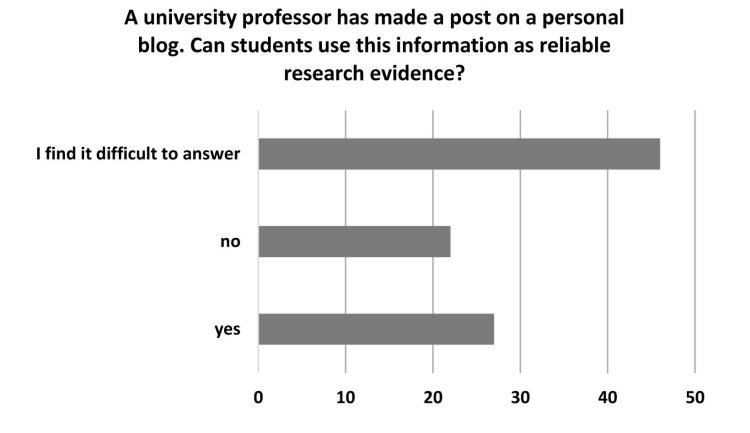
To the follow-up ‘why’ question, a considerable number of the participants’ answers (69%) can be generalized as not being able to justify
their previous response. Most of them left the response blank or responded that they were not sure about it. The rest of the answers (31%) to the open-ended question can be summarized as follows: this is a personal blog and is not scientific evidence; just because the author teaches at university, his/ her information cannot be considered scientific; the information provided on the blog might not necessarily be useful for students.
To the question about Wikipedia, most of the participants i.e., 62% of them, responded that it was acceptable, 30% responded otherwise. 8% of the respondents left the question blank or answered they found it difficult to answer (Figure 2).
Figure 2 Responses to Question 3
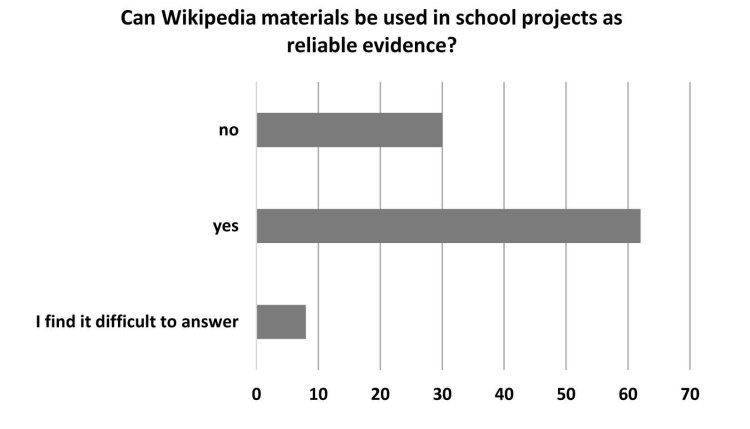
In the next open-ended question about a webpage, a great majority i.e., 81%, left the question blank or responded that they could not answer. The answers of the remaining 19% can be summarized as follows: I see no issues; there are some spelling issues in the source; the title is too long; I don’t believe this source; this looks like a Wikipedia article; there were too many commercials on the page, and it made me feel uncomfortable.
Overall, what is clear from this evidence about evaluating authority is that with the exception of few, the majority of the students did not demonstrate confidence with regard to evaluating authority on the web.
Detection of Logical Fallacies
To the question about distinguishing emotionally loaded texts: 52% said yes, 30% said no and 18% said they found it difficult to answer
(Figure 3).
Figure 3 Responses to Question 5
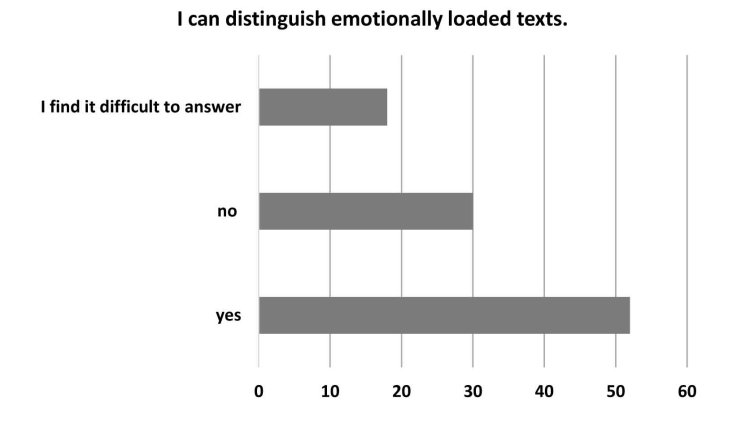
To the next question on the fallacy, 37% responded yes, 39% said no, 24% found it difficult to answer (Figure 4).
Figure 4 Responses to Question 6
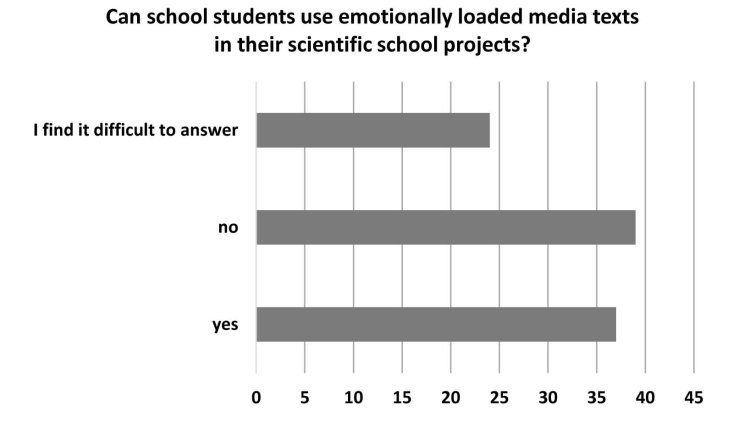
In the follow-up open-ended question ‘why?’ a considerable majority of the respondents i.e., 93% left this question blank or admitted that
they could not answer the question. The answers of only 7% can be summarized as follows: emotionally loaded media texts are not suitable for scientific school projects; it is useful to add emotions to a school project; such materials cannot be used as actual evidence.
To the close-ended question focused on overgeneralized texts, 47% responded yes, 41% said no, 12% found it difficult to answer (Figure 5).
Figure 5 Responses to Question 8
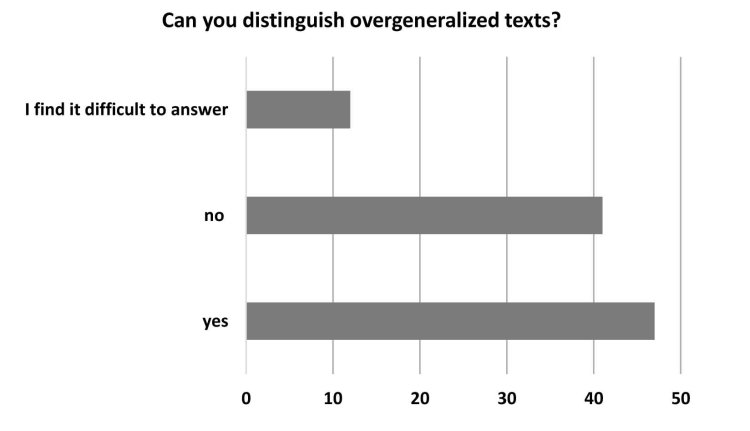
After it, to the following question, 26% responded yes, 38% said no, 36% found it difficult to answer (Figure 6).
Figure 6 Responses to Question 9
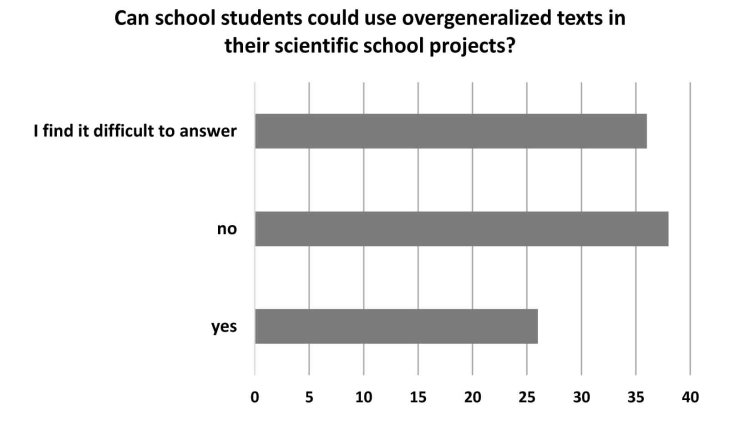
In the follow-up open-ended question ‘why?’, an overwhelming majority of the respondents, i.e., 87%, either left the answer blank or responded that they were not able to answer. The answers of 13% can be summarized as follows:
I do not consider it a proven source; because the information from that source might not be precise; a student should use scientific facts in school projects.
Overall, the participants demonstrated similar rates of answers about emotionally loaded and overgeneralized texts. This evidence shows that the students do not seem to be quite prepared or confident not only about explaining why logical fallacies could distort the quality of school projects but also about the essence of those elements.
CONCLUSIONS AND RECOMMENDATIONS
Information literacy and critical thinking have long been established as associated areas. (Allen, 2008; Hollis, 2019; Godbey & Dema, 2018; Lee, Reed, & Laverty, 2012; Smith, 2013; UNESCO, 2013; Williams & Coles, 2007). This study sought to explore how prepared students of teacher education are and how confidently they perceive themselves in terms of critical thinking concepts related to web-based information literacy at various universities of Azerbaijan. On the basis of the collected evidence, it appears that most of the study respondents seemed to be neither familiar nor confident with the essence of critical thinking concepts in terms of web-based information literacy. The results are in line with Godbey and Dema (2018) and Lee, Reed and Laverty’s (2012) findings. This highlights a broader issue of digital naivety where teacher education students might not fully understand the potential pitfalls of relying on unreliable sources and being unaware of how to contextualize web-based information.
The study participants seemed to be more confident with close-ended questions rather than open-ended. In open-ended questions, they could not elaborate on why they responded so in the preceding questions indicating a potential lack of practice in articulating their thought processes when evaluating sources. In addition, this puts even the correctly answered parts of the survey under question.
In the first part of the survey, it was observed that the students are not well-prepared in terms of the evaluation of authority on the web. This could mainly be due to attaching high significance to positions, ranks or titles of an author, popularity of a website rather than proper credibility indicators of a source.
Furthermore, an interesting aspect of investigation in this section of the survey was Wikipedia, which, based on the previous responses, did not produce positively surprising results. A great portion of the students could not acknowledge credibility issues of this source and responded that Wikipedia materials could be useful as research-based evidence. This suggests that students do not seem to comprehend the nuances of using crowd-sourced platforms for academic research.
Likewise, a trend for not recognizing credibility gaps was also demonstrated in the part of the survey where most students did not point out problems regarding lack of citation on the presented webpage. The webpage contained a phrase ‘according to recent research’, which might well be a reason for them not recognizing non-credibility of the presented webpage.
Overall, the results about the first section of the survey indicate that authority existence in each question i.e., the title of a university professor, encyclopedic look and popularity of a website and a formal phrase, might have caused faulty evaluation of the source by the pre-service teachers.
Furthermore, based on the second part of the survey, the findings suggest that another room for improvement among teacher education students is lack of confidence about the concept of logical fallacies. The two major types of logical fallacies investigated, i.e., overgeneralization and emotional appeal, seemed to be unfamiliar concepts for most. Thus, it explains the students’ inability to justify why overgeneralized and emotionally loaded texts, which have become widely ubiquitous on the web and caused considerable bias spread, might distort the quality of school projects. Even those claiming confidence about knowing the problematic nature of logical fallacies were not able to provide open-ended answers to why they thought so.
All of this evidence seems to signify that web-based information literacy and critical thinking concepts are the areas requiring more attention from educators of teacher education programs.
In response to the results of the present study, the paper argues that taking a multidisciplinary approach by combining the two constructs i.e., critical thinking and web-based information literacy, in a course might allow for a more responsive ground in teacher education programs of Azerbaijan. This suggested practice is likely to respond to future schoolteachers’ current gaps in knowledge and skills by preparing them for the ever-changing web-information world. The need for the approach is grounded by the fact that the modern web is not immune to fake news, misinformation, and bias, and requires sound and specific knowledge of critical thinking concepts for coping with it. Furthermore, teachers’ role is indispensable in formulating critically thinking minds for interacting with web information.
Teaching information literacy only in terms of librarianship only presents a limited picture. Thus, modern web-based information literacy instruction should not be viewed as a standalone module limited by technical sides of critical evaluation but should rather allow space for more contextual and meaningful analysis of information. It assumes teaching information literacy through not only mere mechanical evaluation of sources, which, by and large, might run the risk of not allowing more in-depth analysis, but also through integration of certain critical thinking concepts into curriculum. As researched by the current study, this could include currently relevant topics such as authority evaluation, reasoning fallacies, emotions and overgeneralization in dissemination of web-based information. For example, when teaching evaluation of a website, not only its domain and other technical features, but also the content and context should be included for a more responsive analysis. Also, this multidisciplinary approach embraces evaluating sources based on the author as opposed to authority for detection of possible biases.
Combining critical thinking concepts and web-based information literacy, would set a more flexible and practical ground for students where they will not be limited only with mechanical evaluation and abstract concepts of critical thinking but rather encourage more practice-based steps for content and context evaluation. Apart from it, this will enable learners to take a more context-based approach in
evaluation rather than a mere mechanical one.
Overall, the study highlights that the investigated teacher education students from Azerbaijan do not seem to be prepared to integrate the skills of the explored concepts, which is critical for the 21st century education. Further research on more specific changes to teacher education curriculum in Azerbaijani universities would be a logical course of action in this domain.
References
1 Albitz, R.S. (2007). The What and Who of Information Literacy and Critical Thinking in Higher Education. Libraries and the Academy, 97-109.
2 Alfino, M., Pajer, M., Pierce, L., & Jenks, K. O. (2008). Advancing Critical Thinking and Information Literacy Skills in First Year College Students. College & Undergraduate Libraries, 81-98.
3 Allen, M. (2008). Promoting Critical Thinking Skills in Online Information Literacy Instruction Using a Constructivist Approach. College & Undergraduate Libraries, 21-38.
4 Behrens, L., & Rosen, L. (2012). Critical Reading and Critique. In L. Behrens, & L. Rosen, A Sequence for Academic Writing (pp. 51-62). Boston: Pearson.
5 Diestler, S. (2012). Becoming a Critical Thinker. Pearson.
6 Godbey, S., & Dema, A. (2018). Assessment and Perception of Information Literacy Skills Among Teacher Education Students. Behavioral & Social Sciences Librarian, 1-15.
7 Goodsett, M. (2020). Assessing the Potential for Critical Thinking Instruction in Information Literacy Online Learning Objects Using Best Practices. Communications in Information Literacy, 227-254.
8 Goodsett, M. (2020). Best Practices for Teaching and Assessing Critical Thinking in Information Literacy Online Learning Objects. The Journal of Academic Librarianship.
9 Hollis, H. (2019). Information Literacy and Critical Thinking: Different concepts, Shared Conceptions. Proceedings of the Tenth International Conference on Conceptions of Library and Information Science. Information Research.
10 Jin, Z., Lalwani, A., Vaidhya, T., Shen, X., Ding, Y., Lyu, Z., Schölkopf, B. (2022). Logical Fallacy Detection. arXiv preprint.
11 Kanmaz, L. (2022). Middle School Teachers’ Critical Thinking Skills and Awareness Towards Teaching Critical Thinking Skills. International Online Journal of Education and Teaching, 1648-1671.
12 Khoiri, N.E., & Widiati, U. (2017). Logical Fallacies in Indonesian EFL Learners’ Argumentative Writing: Students’ Perspectives. Dinamika Ilmu, 71-81.
13 Knight, C., & Pryke, S. (2012). Wikipedia and the University, a case study. Teaching in Higher Education, 649-659.
14 Liu, Z., & Huang, X. (2013). Evaluating the credibility of scholarly information on the web: A cross cultural study. The International Information & Library Review, 99-106.
15 McGrew , S., Breakstone, J., Ortega, T., Smith, M., & Wineburg, S. (2018). Can Students Evaluate Online Sources? Learning From Assessments of Civic Online Reasoning. Theory & Research in Social Education, 165-193.
16 McMullin, S. L. (2018, May). Retrieved from University Libraries: https://digital.library.unt.edu/ark:/67531/metadc1157649/m2/1/high_res_d/MCMULLINDISSERTATION-2018.pdf
17 Milbourn, A. (2013). A Big Picture Approach: Using Embedded Librarianship to Proactively Address the Need for Visual Literacy Instruction in Higher Education. Art Documentation: Journal of the Art Libraries Society of North America, 274-283.
18 November, A. (2008). Web Literacy for Educators. Thousand Oaks: Corwin Press.
19 Schultz, C.L. (1995, June). Development of an Information Literacy Course for Community College Students. Blacksburg, Virginia, United States of America.
20 Smith, J. K. (2013). Secondary teachers and information literacy (IL): Teacher understanding and perceptions of IL in the classroom. Library & Information Science Research, 216-222.
21 Taylor, L. H. (2008). Information Literacy in Subject-Specific Vocabularies: A Path to Critical Thinking. College & Undergraduate Libraries, 141-158.
22 UNESCO. (2013). Media and Information Literacy: Policy and Strategy Guidelines. France.
23 Warrington, K., Kovalyova, N., & King, C. (2020). Assessing Source Credibility for Crafting a Well-Informed Argument. In D. Driscoll, M. Stewart, & M. Vetter, Writing Spaces: Readings on Writing (pp. 189-203). South Carolina: Parlor Press LLC.
24 Williams, D., & Coles, L. (2014). Teachers’ approaches to finding and using research evidence: an information literacy perspective. Educational Research, 185-206.
25 Witt, S. W., & Dickinson, J. B. (2008). Teaching Teachers to Teach: Collaborating with a University Education Department to Teach Skills in Information Literacy Pedagogy. Behavioral & Social Sciences Librarian, 75-95.




